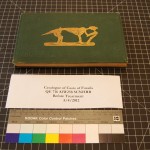 Paper repair is an elusively simple repair. Using wheat starch paste and Japanese paper we repair tears in paper in a manner that is flexible and reversible. The trick to a good paper repair is select the proper color and weigh of repair tissue.
Paper repair is an elusively simple repair. Using wheat starch paste and Japanese paper we repair tears in paper in a manner that is flexible and reversible. The trick to a good paper repair is select the proper color and weigh of repair tissue.
Author: Katie Wagner

The conservation lab received, from the American Art Museum/National Portrait Gallery Library, a first edition of the first Bauhaus exhibition catalog: Staatliches Bauhaus, Weimar, 1919-1923. In addition to being a rare copy of this catalog, it is inscribed to the painter Werner Drewes by his Bauhaus teacher, Wassily Kandinsky.
The book was in disrepair with the covers detached. A spine “replacement” fashioned out of a piece of electrical tape had left tape residue on the Herbert Bayer designed cover. Additionally, the paper used for the catalog was highly acidic and discolored and the acidic clay coated plates were chipping.

What is a full treatment exactly, in book preservation terms? A full treatment entails the dis-binding, washing, drying, re-sewing and re-casing of a book. In the case of Exploration Scientifique de L’Algérie, the book came to us from the Cullman Rare Book Library because it had previously been damaged by water and mold. In order to clean, flatten and remove the mold from the book, we needed to take it apart section by section, page by page.
A constant challenge in the Book Conservation Lab is housing items of disparate sizes together. Recently we faced this issue in re-housing the pamphlet “Instructions in Reference to Collecting Nests and Eggs of North American Birds.” The pamphlet came to us in pieces in an envelope bearing the name of former Secretary of the Smithsonian, Alexander Wetmore.
 A treatment we commonly perform in the Conservation Lab is re-backing. A weak point in many case bound books is the gutter. When it fails the spine typically deteriorates and falls off the back of the book. A re-backing replaces the original spine and enables the book to be used again without sustaining further damage.
A treatment we commonly perform in the Conservation Lab is re-backing. A weak point in many case bound books is the gutter. When it fails the spine typically deteriorates and falls off the back of the book. A re-backing replaces the original spine and enables the book to be used again without sustaining further damage.
 The Book Conservation Lab periodically receives artist’s books from the Cooper-Hewitt National Design Museum Library with special housing needs.
The Book Conservation Lab periodically receives artist’s books from the Cooper-Hewitt National Design Museum Library with special housing needs.




